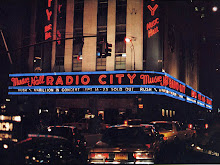 Well, for me, they never really went anywhere, with the exception of the hiatus in the late 90s, and that was due to exceptional circumstances out of the band's control.
Well, for me, they never really went anywhere, with the exception of the hiatus in the late 90s, and that was due to exceptional circumstances out of the band's control.This is more for the general public and how the band has been received in that light. It's one of the better interviews about the band of recent history...it gives some interesting insights into their future.
The Rosetta Stone on how they've kept it going for so long? It's simpler than you might think.
Friendship.
In addition to touring ceaselessly, that's the essential ingredient that's kept the band alive for so long...but it's more fun to hear about it straight from them than to hear me go on and on, so I'll shut up now.
Rush is Back: Pop culture proclaims the formerly dorky band cool
Rush has spent nearly 35 years being uncool; the antidote to hip.
Its songs have been derided by critics as musically out of fashion, and lyrically obtuse. (Drummer Neil Peart, who writes the songs, was chosen by Blender magazine as second only to Sting as worst rock lyricist.)
But it’s not just critics who’ve slagged the band.
In the 1999 movie SLC Punk! a flashback to future Salt Lake City punkers Stevo and Bob shows the pair as junior high school nerds playing Dungeons and Dragons in a basement while listening to Rush’s “Trees,” an allegorical tale set in a forest. Then Bob offers something “new” — “Kiss Me Deadly” by Generation X — and their lives change.
The indie film’s message is less than subtle: Rush is a fossil; even worse, it’s the group of choice for teenage dorks, geeks, and nerds alike.
But the winds of fortune have changed in Rush’s favor, beginning with a Rolling Stone profile of the band in its July 10 issue, a first for the magazine.
Suddenly, Rush is everywhere: performing its biggest hit, “Tom Sawyer,” on The Colbert Report; appearing on VH-1 Classic in a 24-hour marathon of the band’s concerts and videos titled “Rush Hashanah” during the Jewish New Year, and having its bestselling album, “Moving Pictures,” available as a complete download in the game Rock Band (one of only a handful of records available so far).
And next year, just in time for the band’s 35th birthday, look for a Rush documentary and a cameo by the band members in the comedy I Love You, Man, starring Paul Rudd, Jason Segel, and Jon Favreau, punctuated by an induction into the Hollywood Walk of Fame.
Given all the love that’s coming the band’s way, dare we now proclaim Rush cool? Perhaps. And how does all this attention make band members feel? Surprised, said guitarist Alex Lifeson, after an early morning spent on the phone talking to reporters to promote the band’s just-released Snakes and Arrows Live DVD.
“We’ve always sort of been outside — well, maybe not a little bit — we’ve always been kind of outside the mainstream, we’ve done things our own way,” Lifeson said. “We have a very strong core following that’s been very loyal and stuck with us for all these years and allowed us to function that way without having a broader appeal. To suddenly be asked to be in films, of course the Rolling Stone thing, and the Stephen Colbert — all these things ... it makes us smile that all of a sudden Rush is a cool thing, when we have not been a very cool thing for a very long time.”
The Canadian power trio — rounded out by Geddy Lee on bass, vocals, and keyboards — are praised by musicians and fans for the members’ prodigious instrumental skills, showcased in early epic prog rock songs about black holes, Greek gods, and totalitarian societies.
As the band members grew older, though, their music matured. They left behind the concept albums to focus on thematic records about the human condition, and social commentary — often with a libertarian point of view.
The band’s sound also grew tighter, smarter, and more straightforward.
In more than three decades of recording, Rush has released 24 records, 17 of which are studio recordings. All 24 of those records have gone Gold, 14 of them have been certified Platinum, and three have gone multiple Platinum. In fact, Rush ranks behind the Beatles, the Rolling Stones and Aerosmith for the most consecutive gold or platinum records by a rock group, for total sales of 25 million records in the United States alone.
“Neil was in the band for two weeks before we did our first gig, so it didn’t allow a lot of time to go over a lot of material,” Lifeson said. “Granted, for the most part we were just opening, so we were only playing for 20-30 minutes. At that time that was only two songs, ‘Finding My Way’ and ‘Working Man,’ but we were also doing some headline club gigs, so we needed to have some decent amount of material. We used to rehearse in the van and in hotel rooms, as much as we could, and then we’d go into these clubs.”
|
The record tanked with fans, and Rush’s management and record label worried if the band had a future. Under duress and uncertain of the future themselves, Rush responded with the band’s first critical hit, “2112,” an epic Ann Rynd-inspired concept album about an oppressive society from the future. “ ‘2112’ is all about independence and bucking the system,” Lifeson said. The album not only stood as a statement to the record label and other doubters, but also as a lifeline to the band.
“The great thing about it was that we connected somehow with our listening audience and the record did very, very well, and it bought us our independence and freedom,” Lifeson said. “And after that we were never ever questioned by the record company or management. Once you have some success it’s a lot easier to write your own rules.”
Rush capped the “2112” tour and that period with a live album, “All the World’s a Stage,” in 1976. Then the band returned to the studio and started working on an album that was even longer, even more progressive, and its fan base grew. By 1980 Rush hit its stride and released in succession arguably its best work: 1980’s “Permanent Waves,” 1981’s “Moving Pictures,” and 1982’s “Signals,” which, between them, continually account for nearly one-third of the band’s setlist material.
Tragedy
In the summer of 1997, Peart’s teenage daughter was killed in a car crash. Less than a year later, his wife succumbed to cancer. Peart was devastated and the band was put on hold, possibly for good. Lee and Lifeson waited to see if their friend and bandmate could heal.
“That was a very, very difficult period. I don’t think I played my guitar or really listened to music much for a year after Selena’s death,” Lifeson said. “And then, of course, complicated with Neil’s wife’s passing, it just knocked everything out of us. As far as we were concerned, the band had very little chance of surviving; I mean, Neil was barely surviving.
“Our goal was to try to get him back on his feet, or help to get him back on his feet as best as we could. It was a very tough thing, it’s a very personal thing that is chronicled in his book Ghost Rider, what he went through. It wasn’t until he finally found some peace and remarried … and his wife, who really knew very little about the band, was the instigator and the catalyst. [She] said to him, ‘This is what you do, this is who you are. You have to really think about getting yourself back into it and not avoiding that sort of thing.’
“And then we got together and he said ‘I think I’m ready to possibly to go back to work.’ It was a slow rebuilding process. It was four years we were off the road, and here’s a guy who played drums every day except Christmas and New Year’s Day who hadn’t played his drums in four years.”
With the band in hiatus, Lee and Lifeson did their own thing, including Lee’s solo disc “My Favorite Headache.” But there was never a moment when the two thought the band could go on without Peart.
“That’s not the kind of band we ever were. Neil would not be a particularly easy guy to replace,” Lifeson said. “The Rush experience for us has been a family experience. Geddy and I live five minutes from each other. This is [after] 40-plus years of knowing each other and we’re still five minutes from each other. I played tennis with him last week, we had dinner the other night, [there’s a] wine tasting next Tuesday — he’s my best friend and we happen to be in a band together. That makes it a little easier to make those decisions about what you would do if they weren’t there anymore. It’s not just a job, it’s a whole life we’ve lived together.”
More greatest hits
Rush has a third greatest hits package due early next year. After that release, its contract with longtime record label Mercury/Atlantic is up. And already there’s online fan speculation about what’s next for the Toronto band. Will Rush re-sign with Atlantic and return to the studio? Or will the band instead hit the road next year to celebrate its 35th anniversary? First things first, Lifeson said.
“Right now we just want rest,” Lifeson said. “We’ve been working really hard for the last seven or eight years on numerous records, tours, and DVDs; it’s been pretty constant through that whole period. We really feel like we need to step back and recharge our batteries and just not think about the band and what we’re going to do. You never know, Geddy and I might do some casual writing in the spring, but I’m guessing we probably won’t do anything until the fall of next year. At that time ... we’ll set out what we’re doing.
“There are a number of options open to us. I think the most likely is that we’ll record another record and tour off that. Working with [“Snakes and Arrows” producer] Nick Raskulinecz, he’s pushing us to think about doing another sort of concept record ... instead of just a thematically conceptual album like the most current records are. Wether we’re up for that kind of thing, I’m not so sure. We’ll have to wait and see.”
Toledo tour stop?
As the conversation winds down, talk pushes to the end of the band. Given that all the members of the group are in their mid-50s, the end of Rush is certainly closer than its beginning. So how would Lifeson like the band to go out? How would he script Rush’s finale?
“That’s a tough question. I don’t know,” Lifeson said. “I was going to say that we go out on this incredible tour where we were just at the top of our game and we moved on and that was it. But at the same time, and I think maybe it’s because I am Canadian, I think I’d like us to rather just go quietly out. Just kind of fade away quietly and not cause a big deal.”
Contact Kirk Baird at:kbaird@theblade.comor 419-724-6734.





















No comments:
Post a Comment